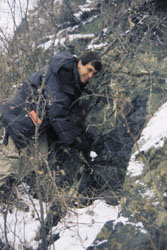 “People argue
about when the modern tectonic regime was started, but when you see an
ophiolite you have to agree that something like modern tectonics was going
on at that time,” Stern says.
“People argue
about when the modern tectonic regime was started, but when you see an
ophiolite you have to agree that something like modern tectonics was going
on at that time,” Stern says.

Within sight of the Great Wall of China, about 250 kilometers northeast of Beijing, are remnants from an ocean that no longer exists. Wedged between two slabs of earth that closed in on each other is a jumble of oceanic rocks and minerals that Chinese and American scientists working together have identified as an ophiolite. The discovery of this complete ophiolite complex dating back to the Archean, 2.5 billion years ago, is a major coup for geophysicists. Until now it was questionable whether ophiolites that old even existed.
“We find ophiolites throughout the Phanerozoic, a couple at 1.9 [billion years] and then this baby, all by itself, at 2.5 [billion years],” says Bob Stern of the University of Texas in Dallas.
Since it takes the spreading of the oceanic crust to give birth to the assemblage of rocks that define an ophiolite, these rocks are an intrinsic part of the story of plate tectonics. It is unclear how much hotter Earth was in the past and in what ways the upper mantle might have been different. Keeping in mind James Hutton’s 18th century mantra that the present is the key to the past, geologists are curious to answer the question of how long Earth has experienced plate tectonics as we know it today.
 “People argue
about when the modern tectonic regime was started, but when you see an
ophiolite you have to agree that something like modern tectonics was going
on at that time,” Stern says.
“People argue
about when the modern tectonic regime was started, but when you see an
ophiolite you have to agree that something like modern tectonics was going
on at that time,” Stern says.
[At left: Tim Kusky measuring and sampling an outcrop of cumulate ultramafic rocks near the village of Gushanzi in the Dongwanzi ophiolite. Photo supplied courtesy of Tim Kusky.]
Before this discovery the geologic community recognized that the collision of plates and extreme folding and faulting of material on par with modern day plate tectonics under which ophiolites are formed was going back almost 2 billion years. This was based on a 1987 identification of a 1.960 billion-year-old ophiolite in Finland and by a 1992 report of a Canadian ophiolite that was 1.998 billion years old. The report of the Dongwanzi, China ophiolite in the May 11 Science pushes the timetable back about 500 million years.
An ophiolite is made up of seven specific components. “The crustal section in the Dongwanzi grades downwards from chert and banded iron formation, into pillow lavas, a laterally extensive sheeted dike complex, into gabbro, layered gabbro, and cumulate ultramafic rocks,” says Timothy Kusky of St. Louis University and lead author of the May 11 report. The assemblage is interpreted to have come from the oceanic lithosphere formed under variable conditions — at mid-ocean ridge spreading centers, above subduction zones, in back-arc basins or as ocean islands — and uplifted onto land.
In 1985, similar but deformed and metamorphosed rocks dated to be more than 2.7 billion years old were found southeast of Yellowstone in the Wind River Range, Wyo. “You couldn’t say for sure this was an ophiolite because it was pretty messed up,” says Greg Harper of the State University of New York in Albany, who found the sequence. Also, none of the ultramafic rocks Harper found was of the type, harzburgite tectonites, that form in the upper mantle. “What Tim found has all the parts.”
Kusky worked with Jiang-Hai Li of Beijing University and Robert Tucker of Washington University in St. Louis to map and date the approximately 50-kilometer-long and five- to 10-kilometer-wide ophiolite, named after a village in the center of the area they mapped.
Last year Li had identified the suture zone where the two parts of the North China craton collided into each other. While on a tour of the area, Kusky saw the collision had lifted what looked like outcrops of an ophiolite sequence: dark colored rocks with the distinctive pattern of sheeted dikes. He was amazed. Sheeted dikes show a pattern of cracks splitting open, filling with lava, crystallizing and then splitting again with the new dike coming up through the old layer.
The sheeted dikes act as conduits from the magma chamber spouting the magma to the sea floor where it forms pillow lavas, like those seen in underwater eruptions off Hawaii. “This dike complex is at least five kilometers long, and maybe as much as 20. We have not finished mapping it yet.” Its size shows the sea-floor extension was significant, he says.
Christina Reed
 |
Geotimes Home | AGI Home | Information Services | Geoscience Education | Public Policy | Programs | Publications | Careers |